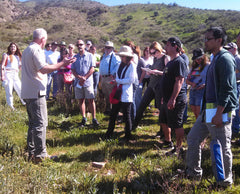Beekeeping Class 101 - Part 1
Share
 How exciting! 119 newbees (Yikes!) showed up for our first class of the 2015 season! What a gorgeous day to be up on the mountain at Bill’s Bees Bee Farm. Bill and Clyde have hosted and taught the Los Angeles County Beekeepers Association Beekeeping Class 101 for quite a few years. Once upon a time, there were only a handful of “newbees” interested in becoming beekeepers. Over the past few years, interest in beekeeping and the desire to learn more about these tiny honey bees who are so important to our survival, has grown around the world.
How exciting! 119 newbees (Yikes!) showed up for our first class of the 2015 season! What a gorgeous day to be up on the mountain at Bill’s Bees Bee Farm. Bill and Clyde have hosted and taught the Los Angeles County Beekeepers Association Beekeeping Class 101 for quite a few years. Once upon a time, there were only a handful of “newbees” interested in becoming beekeepers. Over the past few years, interest in beekeeping and the desire to learn more about these tiny honey bees who are so important to our survival, has grown around the world.
So now you want to be a beekeeper!!! You’ve come to the right place. We offer a great series of classes for both beginners and established beekeepers. We’ll walk you through a season of beekeeping; from where to get your bees, what you’ll need in the way of protective clothing, tools and equipment, how to care for your bees, and when and how to extract honey.
With the joy of beekeeping also comes the responsibility to your bees, your neighbors, and yourself. We teach responsible beekeeping for an urban environment, adhering to best management practices for the bees, the beekeepers, and the general public. Keeping bees can be daunting and there’s a lot to learn. As the beekeeper will tell you, “Ask ten beekeepers a question, and you’ll get eleven answers.” You'll make mistakes, we all do. But you’ve entered a wonderful community whose passion is honey bees. We’re here to help you become the best beekeeper you can be.
In our first class we discussed some of the preliminary planning considerations, tools and equipment, and beekeeping resources. In April you’ll be picking up your bees (hope you’ve got your bee order in, they’re going fast!). Below are some things to consider and plan for before you pick up your bees. In our next blog we’ll share the essential tools and equipment you’ll need before you bring your bees home.
Location, Location, Location:
- A location in the open, preferably with a southern or easterly exposure, for maximum sunshine throughout the day.
- Away from animals and children, not along a foot path, or where there is direct traffic.
- Protected by a barrier (approx. 2 feet from - and facing a hill or wall) from wind, streets, etc. This will also force the bees to fly up and over cars, people, etc., thus causing them to be less of a nuisance and helping them to stay alive.
- Ease of access (you don’t want to be lifting heavy supers of honey up and down stairs or across rocky fields).
What the bees will need:
- A safe, natural habitat with a source for nectar and pollen. A typical honey bee colony forages more than 80,000 square yards to find plants and flowers with sufficient nectar (honey) the bees' source for energy and pollen (essential in brood rearing) the bees' source of carbohydrates.
- A nearby source of fresh water (within ¼ mile) so they don’t use the neighbor’s swimming pool. This can be a tank or barrel of water with rocks or floating boards or cork for the bees to land on.
- A safe, comfortable, home to live in.
We suggest you buy a couple of good beekeeping books and read them all the way through, twice. Here’s some suggestions:
- Beekeeper’s Handbook
- Keeping Bees in Towns & Cities
- How to Keep Bees & Sell Honey
- Beekeeping for Dummies
Our next class is March 15th at The Valley Hive, where you’ll learn woodworking, how to build bee boxes, frame assembly, and how to prepare your hive for your bees. All future classes will be at Bill's Bees Bee Yard.
We don't send out notices or emails of changes in dates, times, location, or schedule. All the information regarding the classes is posted on the website: Los Angeles County Beekeepers Association Beekeeping Class 101 and on the Los Angeles County Beekeepers Association Facebook page.
We welcome you to the wonderful, exciting world of beekeeping. We are forever grateful for the 'Gift of the Bees!' Join us!
Thank you!
Bill and Clyde
Bill's Bees
